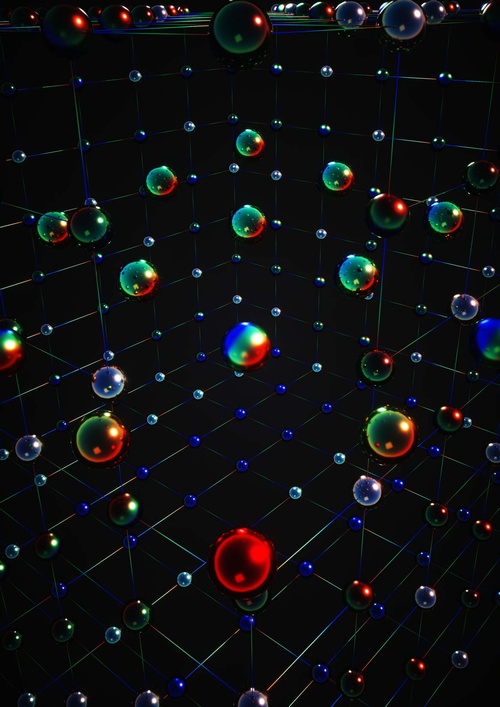Space is cold, of course, but is warmed by the afterglow from the Big Bang. A Kyoto team instead used lasers to cool its fermions, atoms of ytterbium, within about one-billionth of a degree of absolute zero, the unattainable temperature where all motion stops, far colder than interstellar space.
Fermions include things like electrons and are one of two types of particles that all matter is made of, and atoms are subject to the laws of quantum dynamics just like electrons and photons are, but their quantum behaviors only become evident when they are cooled within a fraction of a degree of absolute zero. Physicists have used laser cooling to study the quantum properties of ultracold atoms for more than a quarter century, which also restricts their movements to optical lattices, 1D, 2D or 3D channels of light that can serve as quantum simulators capable of solving complex problems beyond the reach of conventional computers.

Artistic rendition of the magnetic correlations physicists have observed with a quantum simulator at Kyoto University that uses ytterbium atoms about 3 billion times colder than deep space. Different colors represent the six possible spin states of each atom. The simulator uses up to 300,000 atoms, allowing physicists to directly observe how particles interact in quantum magnets whose complexity is beyond the reach of even the most powerful supercomputer. Image by Ella Maru Studio/Courtesy of K. Hazzard/Rice University
The team used optical lattices to simulate a Hubbard model, an oft-used quantum model created in 1963 by theoretical physicist John Hubbard. They are often used to investigate the magnetic and superconducting behavior of materials, especially those where interactions between electrons produce collective behavior, somewhat like the collective interactions of cheering sports fans who perform “the wave” in crowded stadiums.
The Hubbard model simulated in Kyoto has special symmetry known as SU(N), where SU stands for special unitary group — a mathematical way of describing the symmetry — and N denotes the possible spin states of particles in the model. The greater the value of N, the greater the model’s symmetry and the complexity of magnetic behaviors it describes. Ytterbium atoms have six possible spin states, and the Kyoto simulator is the first to reveal magnetic correlations in an SU(6) Hubbard model, which are impossible to calculate on a computer.
The team showed it could trap up to 300,000 atoms in its 3D lattice. Hazzard said accurately calculating the behavior of even a dozen particles in an SU(6) Hubbard model is beyond the reach of the most powerful supercomputers. The Kyoto experiments offer physicists a chance to learn how these complex quantum systems operate by watching them in action.
The next challenge is creating tools capable of measuring such behavior in the Kyoto experiment.





Comments